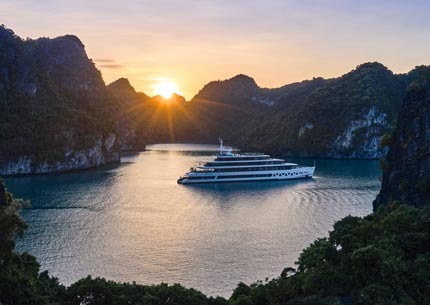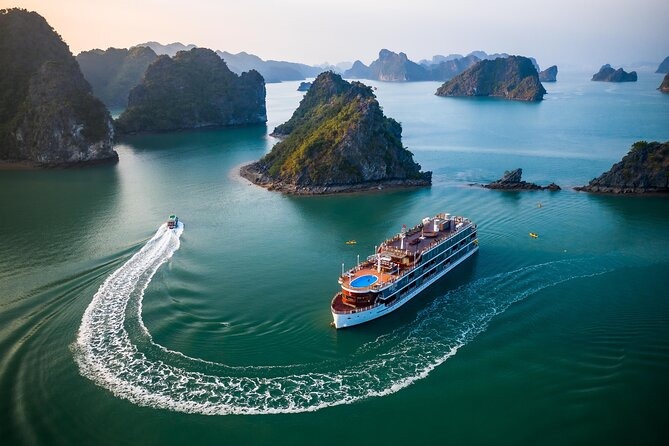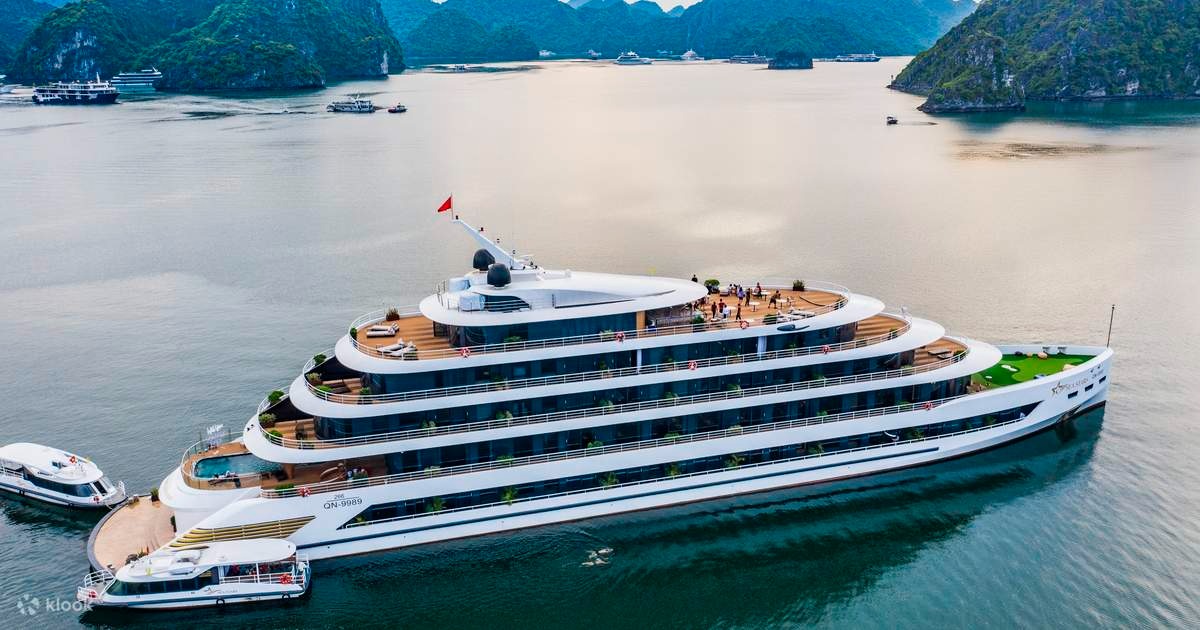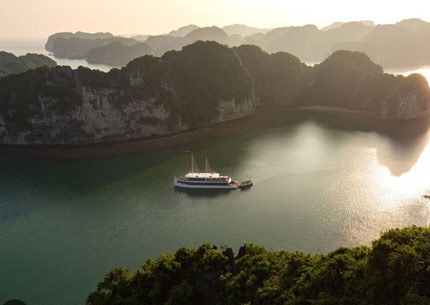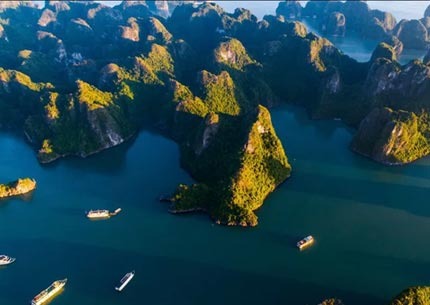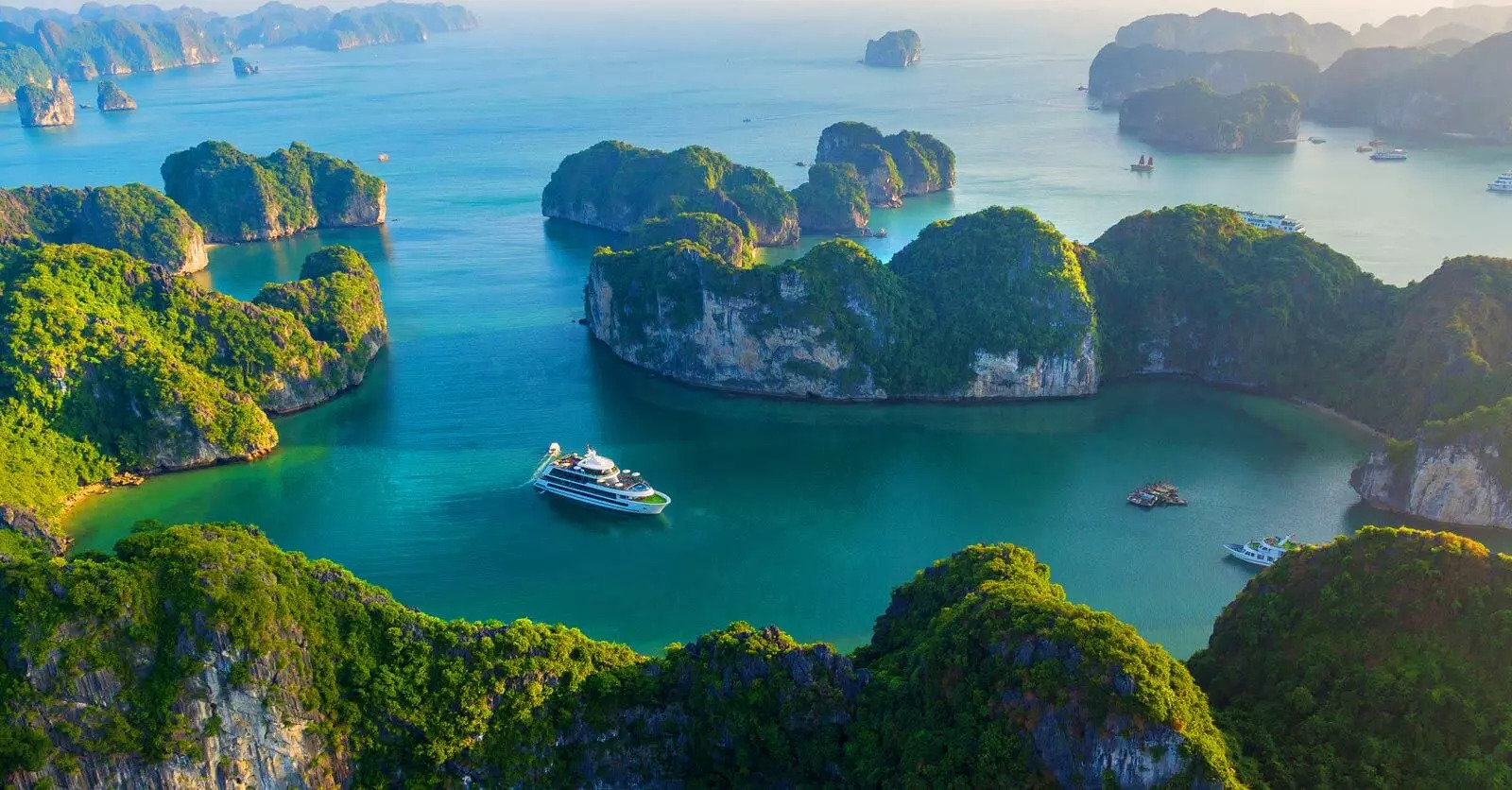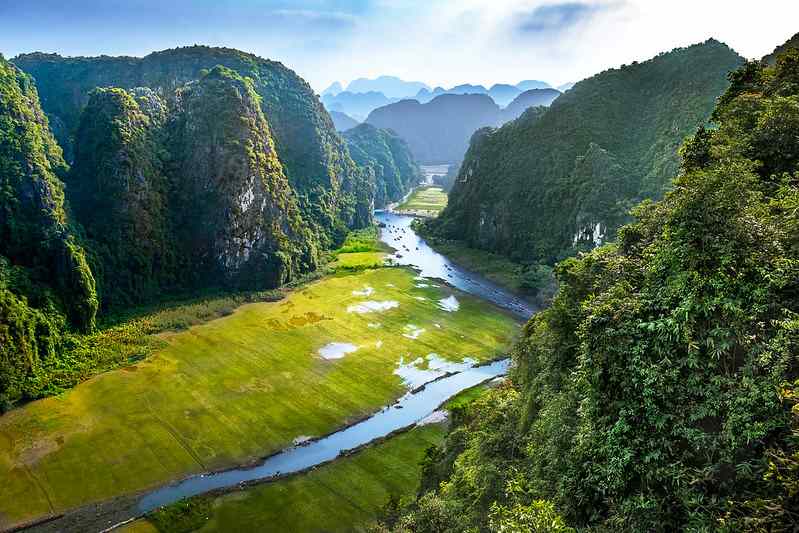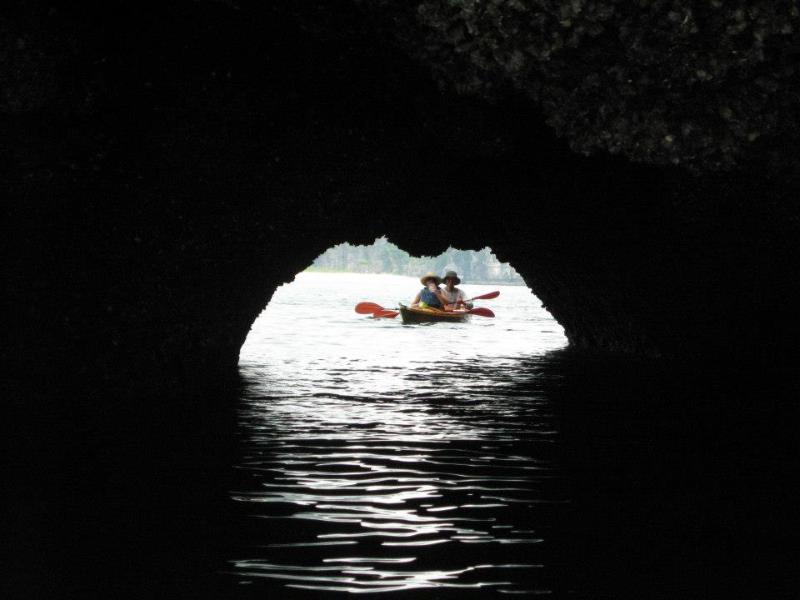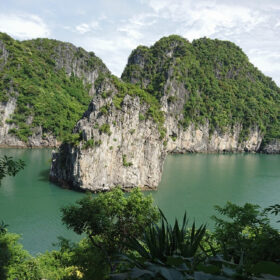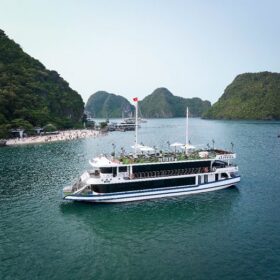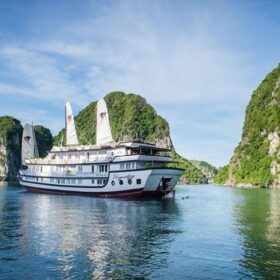21 Famous Destinations in Bai Tu Long Bay for Perfect Exploration in 2025-2027
Discover the untouched splendor of Northern Vietnam with our comprehensive guide to Bai Tu Long Bay’s most spectacular locations. From serene fishing villages to hidden caves, these destinations offer the authentic experiences that travelers are increasingly seeking in 2025-2027.
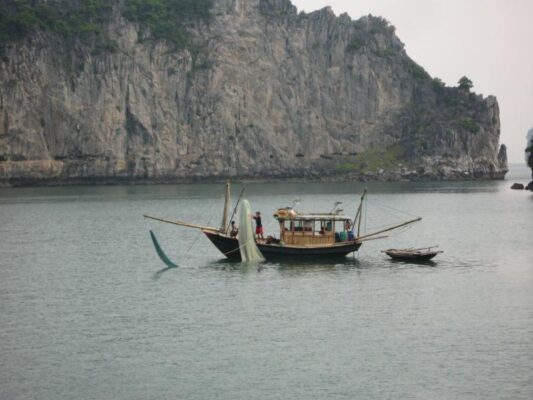
1. Vung Vieng Fishing Village — A Living Maritime Heritage
Tucked away in the heart of Bai Tu Long Bay, Vung Vieng stands as one of the last authentic floating villages in the region. Home to approximately 300 residents across 55 households, this cultural treasure provides visitors with a rare glimpse into Vietnam’s traditional maritime lifestyle that has remained largely unchanged for centuries.
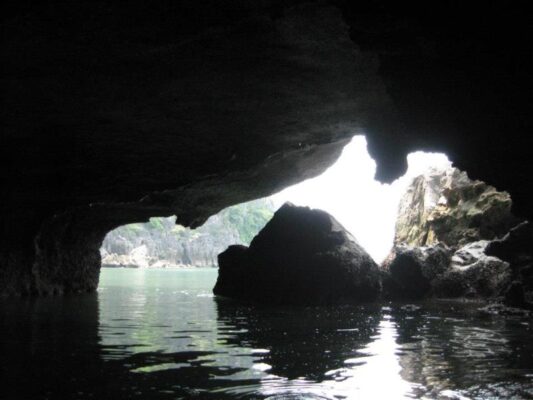
The Cultural Experience of Vung Vieng
Upon arriving at Vung Vieng, visitors are greeted by friendly locals who offer guided bamboo boat tours through the village. These 45-minute excursions provide intimate access to the community’s daily routines, from pearl farming operations to traditional fishing methods. The village’s fishing culture museum, established in 2014, houses over 200 artifacts that document the evolution of local maritime practices.
What makes Vung Vieng special: Unlike more commercialized villages in Ha Long Bay, Vung Vieng maintains authentic living traditions, with residents still practicing time-honored fishing techniques and craft-making that date back generations. The village spans approximately 7.5 hectares across the sheltered waters, creating a harmonious balance between human habitation and natural beauty.
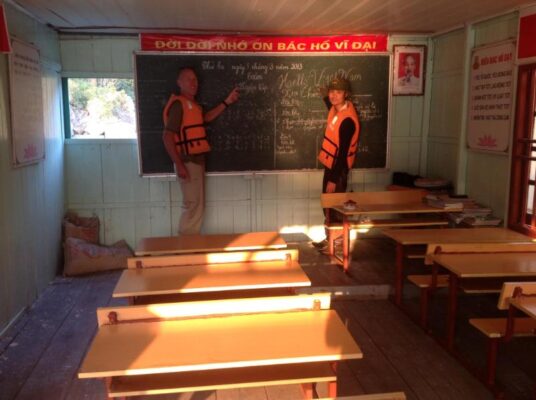
2. Thien Canh Son Cave — Nature’s Underground Masterpiece
Perched majestically on Hon Co Island, Thien Canh Son Cave has become increasingly popular among travelers seeking natural wonders. The cave entrance sits 25 meters above sea level, accessible via a carefully constructed stairway of 96 stone steps.
Inside the Geological Wonder
The cave’s interior stretches approximately 220 meters in length, featuring a central chamber that reaches 30 meters in height at its tallest point. Inside, visitors discover an extraordinary collection of stalactites and stalagmites that have formed over millions of years. The cave’s natural limestone formations create shapes resembling dragons, phoenixes, and lotus flowers—each illuminated by strategically placed lighting that enhances their natural beauty without disrupting the cave ecosystem.
The panoramic view from the cave’s entrance platform spans approximately 2 kilometers across the bay, offering one of the most photogenic vistas in all of Northern Vietnam. The striking contrast between the emerald waters below and the limestone karsts jutting dramatically from the sea creates an unforgettable backdrop for photography enthusiasts.
Planning a multi-day exploration of these natural wonders? Consider our 3-day luxury cruise through Lan Ha and Halong Bay for an immersive experience that includes Bai Tu Long’s highlights with premium accommodations.
3. Cong Do Island — Marine Biodiversity Sanctuary
Covering 23.36 square kilometers within the protected Bai Tu Long National Park zone, Cong Do Island represents one of the region’s most significant ecological treasures. Marine biologists have documented over 234 species of coral here—approximately 78% of all coral species found in Vietnam’s waters.
Exploring Cong Do’s Underwater Paradise
The waters surrounding Cong Do maintain exceptional visibility of up to 10 meters during optimal conditions, making it ideal for snorkeling and diving. Visitors can observe vibrant coral gardens that serve as habitats for more than 450 species of fish, 200 species of crustaceans, and numerous other marine organisms.
The island’s 9-kilometer mangrove forest system functions as a critical carbon sink, absorbing an estimated 12 tonnes of carbon dioxide per hectare annually. These mangroves also serve as natural barriers against coastal erosion, protecting the island’s delicate ecosystem from storm damage.
What makes Cong Do special: The area features a unique combination of limestone karst ecosystems above water and thriving coral reef systems below, creating a comprehensive biodiversity hotspot that scientists continue to study for its ecological significance and resilience to climate change.
4. Ban Chan Beach — Pristine Coastal Retreat
While most beaches in Ha Long Bay have experienced increasing visitor numbers, Ban Chan Beach remains remarkably unspoiled. This 400-meter stretch of pristine shoreline offers fine white sand with a silica content of approximately 85%, giving it a distinctive powdery texture that feels luxurious underfoot.
The Perfect Beach Day Experience
Ban Chan’s sheltered position among towering limestone formations creates a natural windbreak, resulting in consistently calm waters with gentle waves rarely exceeding 30 centimeters in height. The beach maintains a water temperature between 22°C and 28°C year-round, making it suitable for swimming during most seasons.
The beach’s orientation provides approximately 7 hours of direct sunlight during summer months, with natural shade available from the surrounding karst formations in the late afternoon—creating ideal conditions for both sun-seekers and those preferring cooler relaxation spots.
Why travelers love Ban Chan: The beach remains uncrowded even during peak seasons, with visitor numbers typically not exceeding 50 people at any given time—a stark contrast to the more popular beaches that can see hundreds of daily visitors. This seclusion creates an atmosphere of exclusive tranquility that increasingly resonates with travelers seeking authentic experiences in 2025-2027.
5. Cap La Island — Kayaker’s Paradise
Cap La Island remains one of Bai Tu Long Bay’s best-kept secrets, offering adventurous travelers access to pristine kayaking conditions across its network of sheltered lagoons. The island features approximately 12 kilometers of navigable waterways suitable for paddlers of all experience levels.
Navigating Cap La’s Hidden Waterways
The island’s main lagoon spans 2.5 hectares and is surrounded by limestone walls reaching heights of up to 100 meters, creating dramatic acoustics where even whispers echo clearly across the water. Water depths in the lagoons vary between 3-15 meters, with exceptional clarity allowing paddlers to observe marine life directly beneath their kayaks.
What makes Cap La unique: The island’s lagoon system includes three hidden passages that are only accessible during specific tide conditions, creating an element of adventure and exploration for visitors. These passages lead to secluded interior lagoons where the water temperature can be up to 2°C warmer than the surrounding bay.
6. Ba Mun Island — Wildlife Sanctuary in Bai Tu Long National Park
As the largest island within Bai Tu Long National Park, Ba Mun covers an impressive 1,800 hectares and rises to an elevation of 397 meters at its highest point. This substantial landmass serves as a crucial biodiversity hotspot, protecting endangered species within its largely undisturbed tropical forest ecosystem.
Discovering Ba Mun’s Ecological Treasures
Ba Mun’s forest canopy covers approximately 92% of the island’s total area, creating a dense habitat that supports over 78 bird species, including the endangered white-breasted kingfisher and Oriental pied hornbill. The island’s mammal population includes approximately 22 species, from palm civets and flying squirrels to rare leaf monkeys.
Conservation significance: Since receiving protected status in 1997, Ba Mun has been instrumental in preserving Vietnam’s biodiversity. Scientific research stations on the island monitor population changes and habitat conditions, with recent studies identifying 37 plant species with medicinal properties used in traditional Vietnamese medicine.
For those interested in combining natural exploration with cultural experiences, our Ninh Binh and Halong Bay 3-day package provides the perfect balance of land and sea adventures in Northern Vietnam.
7. Hon Co Island — Romantic Hideaway
Hon Co Island has earned its reputation as the “Romantic Heart of Bai Tu Long Bay” due to its heart-shaped outline when viewed from certain angles. The island covers approximately 6.5 hectares and features dramatic limestone cliffs that rise to a height of 187 meters.
The Island of Natural Romance
Beyond housing the famous Thien Canh Son Cave, Hon Co offers three secluded beaches totaling 250 meters of shoreline. The main beach on the eastern side spans 120 meters and features sand with a unique pinkish hue due to fragments of red coral mixed with white silica.
What couples love about Hon Co: The island’s western face catches the sunset in spectacular fashion, with sunlight illuminating the limestone in golden hues for approximately 30 minutes each evening. This natural light show has made it increasingly popular for engagement photography, with an estimated 200 couples choosing it as their proposal location in 2024 alone.
8. Tra Gioi Beach — Photographer’s Dream Destination
Located on the southeastern edge of Bai Tu Long Bay, Tra Gioi Beach has become legendary among photographers for its exceptional light conditions. The beach’s east-west orientation allows it to capture both sunrise and sunset views, with golden hour lighting lasting approximately 45-60 minutes during optimal conditions.
Capturing Tra Gioi’s Magical Light
The beach extends for 350 meters along a gradually curving shoreline, providing multiple vantage points for composition. The shoreline is lined with weather-sculpted limestone boulders that create natural framing elements for photographs. These distinctive rock formations, some standing up to 4 meters tall, have been shaped by erosion into artistic forms that photographers use as foreground interest.
What makes Tra Gioi a photographic haven: The beach’s position relative to surrounding islands creates a natural light box effect, with sunlight reflecting off the water and limestone cliffs to produce soft, diffused illumination even on cloudy days. Drone photographers particularly value the location for its dramatic aerial perspectives, with the beach’s curved shoreline creating leading lines that draw the eye across the landscape.
9. Ang Du Area — Hidden Karst Lagoon System
The Ang Du area represents one of Bai Tu Long Bay’s most spectacular geological formations, featuring a complex network of interconnected lagoons enclosed by towering limestone walls. This natural wonder spans approximately 4.5 hectares of protected water, with limestone karsts creating a nearly complete circular enclosure.
Navigating Ang Du’s Tranquil Waters
The entrance to Ang Du’s main lagoon measures just 15 meters across, making it accessible only to small boats and kayaks. Once inside, visitors discover a sheltered aquatic environment where water depths range from 3 to 20 meters, with exceptional clarity due to the limited water exchange with the main bay.
What makes Ang Du remarkable: The lagoon’s nearly enclosed nature creates unique acoustic properties, with sound waves reflecting off the surrounding limestone walls to create natural amplification. Voices spoken at normal volume can be heard clearly up to 100 meters away, creating an almost magical atmosphere that has earned it the nickname “Echo Lagoon” among guides and visitors.
Experience the magic of these secluded areas with our 2-day Halong and Lan Ha Bay 5-star cruise, which includes expert-guided excursions to the most photogenic locations.
10. Thay Cave (Hang Thầy) — Spiritual Sanctuary
Thay Cave represents one of Bai Tu Long Bay’s most significant historical and spiritual sites, with archaeological evidence suggesting human habitation dating back approximately 3,500 years. The cave extends 480 meters into the limestone mountain, with a main chamber measuring 60 meters across at its widest point.
Exploring Thay Cave’s Cultural Heritage
The cave’s name, which translates to “Teacher’s Cave,” derives from its historical use as a meditation retreat for Buddhist monks during the Ly Dynasty (11th-13th centuries). Inside, visitors discover ancient shrines including a central altar dating to approximately 1729, where locals still place offerings during traditional festivals.
Historical significance: The cave contains over 30 ancient inscriptions carved into its walls, the oldest dating to 1297 CE. These inscriptions, written in ancient Vietnamese Nom script and classical Chinese, provide valuable historical records of the region’s cultural and religious development. Archaeological excavations conducted between 2018-2020 uncovered pottery fragments and tools dating to the Dong Son culture (1000 BCE – 100 CE).
11. Cong Dam Area — Geological Time Capsule
The Cong Dam area offers a fascinating window into Earth’s ancient past, with rock formations that geologists have dated to approximately 340 million years ago (Late Devonian to Early Carboniferous periods). This remarkable geological landscape covers approximately 18 square kilometers and features some of the most dramatic karst formations in all of Northern Vietnam.
Understanding Cong Dam’s Geological Significance
The area displays clear evidence of the region’s complex geological history, with visible layers of limestone, dolomite, and shale that record ancient environmental changes. Scientists have identified fossilized remains of over 40 marine species within these rock layers, including prehistoric corals, mollusks, and crinoids that inhabited the ancient seas.
What makes Cong Dam exceptional: The area features a rare geological phenomenon known as “karst windows” – natural openings in the limestone ceiling that allow sunlight to penetrate enclosed lagoons. The largest of these openings measures approximately 35 meters across and creates dramatic light beams that pierce the water below, illuminating the underwater landscape to depths of up to 8 meters in clear conditions.
12. Mat Quy Island (Monster Head Islet) — Nature’s Sculpture
Rising dramatically from the emerald waters of Bai Tu Long Bay, Mat Quy Island earned its name (“Monster Head”) from its distinctive profile that bears an uncanny resemblance to a creature emerging from the sea. This natural limestone formation stands approximately 48 meters tall and has a circumference of roughly 400 meters at its base.
The Geological Marvel of Mat Quy
The island’s distinctive shape resulted from millions of years of differential erosion, where varying limestone hardness created the appearance of facial features. Wind and water erosion have carved what appear to be eyes, nostrils, and a mouth into the rock face, with the “mouth” formation measuring approximately 12 meters wide.
What makes Mat Quy a must-see landmark: Beyond its striking appearance, the island serves as home to several rare plant species that have adapted to grow directly on limestone, including four varieties of orchids found nowhere else in the bay. Marine biologists have documented unusually high fish populations in the waters immediately surrounding the island, attributed to the complex underwater topography that creates ideal breeding conditions.
13. Da Xep Park — Adventure Kayaker’s Challenge
Da Xep Park presents one of Bai Tu Long Bay’s most rewarding adventures for kayaking enthusiasts. This intricate maze of limestone formations covers approximately 5.8 square kilometers and features narrow passages, hidden lagoons, and dramatic rock arches that create a natural obstacle course for paddlers.
Navigating Da Xep’s Limestone Labyrinth
The park contains over 20 navigable channels ranging from 3 to 30 meters in width, with some passages so narrow that kayakers must maneuver carefully to avoid touching the limestone walls on either side. Water depths throughout the area vary dramatically, from shallow 1-meter sections to deep channels exceeding 15 meters.
What makes Da Xep special for adventurers: The park’s complex topography creates varying water conditions even within short distances. Paddlers can experience gentle currents in open areas, followed by more challenging flows where channels narrow. This diversity makes it suitable for kayakers seeking progression in their skills, with guides typically selecting routes based on experience levels.
14. Minh Chau Beach — Family-Friendly Coastal Haven
Stretching for 1.2 kilometers along Quan Lan Island’s eastern shore, Minh Chau Beach offers one of the most accessible and well-appointed beach experiences in the Bai Tu Long archipelago. The beach features exceptionally fine sand with a distinctive white color due to its high quartz content (approximately 90%).
Perfect Family Beach Day Experience
Minh Chau’s gently sloping shoreline creates ideal swimming conditions, with water depths increasing gradually to reach just 1.5 meters at approximately 30 meters from shore. This gradual progression makes it particularly suitable for families with children. The beach faces east, providing shelter from prevailing winds and resulting in calm waters with waves typically not exceeding 40 centimeters in height.
Family-friendly amenities: The beach area features 12 permanent cabanas available for day rental, clean public restrooms with shower facilities, and a designated children’s play area covering 400 square meters with equipment suitable for ages 3-12. Local restaurants serve fresh seafood caught daily by island fishermen, with specialties including Quan Lan’s famous sweet-flesh clams harvested from the surrounding waters.
15. Quan Lan Island Market — Cultural Commerce Hub
Quan Lan Island Market is the commercial and social hub of the Bai Tu Long archipelago. Spanning 2,800 square meters, it draws vendors from nearby islands and mainland villages into a lively trading center.
Immersive Market Experience
The market operates daily from 6:00 AM to 11:00 AM, with peak activity occurring between 7:30 AM and 9:00 AM when approximately 80 vendors display their goods. Visitors can browse through 40+ stalls selling fresh produce, with a particular emphasis on seafood including 15+ varieties of fish, crustaceans, and mollusks caught in local waters.
Cultural significance: Beyond commercial transactions, the market functions as an important social gathering place where information is exchanged and community bonds are strengthened. Visitors can observe traditional bargaining practices and gain insight into the economic structure of island communities that have adapted to balance traditional fishing practices with growing tourism.
16. Quan Lan Island — Historical Maritime Crossroads
Quan Lan Island is more than its beach—it was a key maritime trading post from the 11th century. Stretching 11 km², it linked Vietnam with China and other Southeast Asian nations along ancient shipping routes.
Exploring Quan Lan’s Rich Heritage
The island is home to historic sites like the Quan Lan Communal House, built in 1520, with 62 carved wooden columns depicting maritime scenes. Nearby, the 17th-century Quan Lan Temple honors sea goddess Ama and houses shipwreck artifacts, including 13th–15th century ceramics.
Between 2016 and 2019, excavations revealed a major port from the Ly and Tran dynasties (11th–14th centuries). Discoveries included foreign coins, Chinese and Japanese ceramics, and remains of wharves built to handle 30-meter vessels.
17. Ngoc Vung Island — Bird Watcher’s Paradise
Ngoc Vung Island has emerged as one of Northern Vietnam’s premier destinations for ornithology enthusiasts. Covering approximately 12.5 square kilometers, this diverse ecosystem provides critical habitat for both resident and migratory bird species, with scientists documenting over 160 different birds throughout the year.
Discovering Ngoc Vung’s Avian Diversity
The island features multiple habitat types, including 350 hectares of mangrove forest, 420 hectares of lowland tropical forest, and 3 kilometers of wetlands that attract different bird species. During peak migration seasons (April-May and September-October), the island hosts up to 20,000 migratory birds using the East Asian-Australasian Flyway.
Conservation significance: Since 2018, Ngoc Vung has been designated as an Important Bird Area (IBA) by BirdLife International due to its support of globally threatened species. The island provides critical habitat for the endangered black-faced spoonbill (Platalea minor), with approximately 45-60 individuals (representing nearly 2% of the global population) wintering here annually.
18. Tien Ong Cave — Archaeological Treasure Trove
Discovered by archaeologists in 2007, Tien Ong Cave has revolutionized our understanding of prehistoric human habitation in Northern Vietnam. This expansive limestone cavern measures approximately 1,000 square meters, with a main chamber reaching 15 meters in height at its tallest point.
Uncovering Ancient Human History
Excavations conducted between 2007-2010 unearthed extraordinary evidence of human occupation dating back approximately 10,000-12,000 years. Archaeologists recovered over 2,500 artifacts including stone tools, pottery fragments, and food remains that provide insight into the daily lives of the region’s earliest inhabitants.
Archaeological significance: The cave contains some of the earliest evidence of maritime adaptation in Southeast Asia, with recovered shells and fish bones suggesting sophisticated fishing and shellfish collection techniques. Carbon dating of human remains found in the cave (representing at least 8 individuals) places them within the Late Paleolithic to Early Neolithic transition period, a crucial time in human development when hunter-gatherer societies began adopting more settled lifestyles.
19. Tra Ban Island — Marine Conservation Success Story
Tra Ban Island is a standout conservation success, with its waters designated as a marine protected area (MPA) since 2010. The 234-hectare island shows how effective protection can drive ecosystem recovery.
Witnessing Ecological Restoration
Prior to protection, Tra Ban’s coral reefs suffered approximately 65% degradation due to destructive fishing practices and climate impacts. Since receiving protected status, scientific monitoring has documented impressive recovery, with live coral cover increasing from 18% in 2010 to over 47% by 2023—a 161% improvement.
Conservation impact: The protected waters surrounding Tra Ban now support over 350 species of reef fish, representing a 40% increase from pre-protection surveys. This includes the return of commercially valuable species that had nearly disappeared from the area, such as the humphead wrasse and blackspot tuskfish. The recovering ecosystem now serves as an important source of marine life that helps replenish surrounding fishing grounds.
20. Sau Nam Island — Geological Research Center
For travelers with scientific interests, Sau Nam Island provides a fascinating window into ongoing geological research. This compact island, covering just 28 hectares, has become an important field station for scientists studying the formation and evolution of karst landscapes in the Gulf of Tonkin.
Understanding Earth’s Geological Processes
The island houses a small research facility established in 2016 through cooperation between Vietnamese and international universities. This center monitors long-term changes in the limestone karsts, collecting data on erosion rates, water chemistry, and the effects of climate change on these fragile formations.
Scientific significance: Research conducted at Sau Nam has documented the island’s unusual rate of geological change, with measured erosion occurring approximately 2.7 times faster than comparable karst formations elsewhere due to its exposure to monsoon weather patterns. These findings contribute to global understanding of how karst landscapes evolve and respond to changing environmental conditions.
21. Bai Tu Long National Park Headquarters — Conservation Education Center
The administrative heart of conservation efforts in the region, the Bai Tu Long National Park Headquarters provides visitors with comprehensive insight into the bay’s ecological significance and ongoing protection initiatives. Established in 2001, this facility oversees conservation activities across 15,783 hectares of land and sea territory.
Learning About Conservation Efforts
The headquarters complex includes a 400-square-meter visitor center featuring interactive exhibits that explain the bay’s biodiversity and geological history. Educational displays highlight the park’s successful conservation programs, including coral restoration projects that have transplanted over 2,000 coral fragments since 2018, achieving an 83% survival rate.
Educational value: The center offers specialized programs for visitors interested in deeper ecological understanding, including guided interpretive hikes, marine conservation workshops, and citizen science opportunities where travelers can contribute to ongoing research projects. These programs align perfectly with the growing trend of educational tourism that’s projected to increase 35% by 2027.
Why Choose Bai Tu Long Bay for Your 2025-2027 Adventure?
As travelers seek more authentic experiences away from overtourism, Bai Tu Long Bay emerges as a peaceful alternative to Ha Long Bay. While Ha Long welcomes around 7 million visitors annually in a 434 km² area, Bai Tu Long sees just 1.2 million spread over 560 km².
This lower density offers a quieter experience, with 70% fewer boats on average during cruises. Environmental data shows the benefits—water clarity is 35% higher, and microplastic levels are much lower than in busier areas.
Looking ahead to 2025–2027, Bai Tu Long is adopting sustainable tourism strategies. From January 2025, new rules will enforce daily visitor limits, mandate eco-friendly engines for new boats, and expand marine protected zones by 15% to safeguard the ecosystem.
Planning Your Bai Tu Long Bay Journey
To experience these 21 famous destinations in Bai Tu Long Bay, consider our premium cruise packages that provide access to the region’s highlights while maintaining the highest standards of comfort and sustainability. Our vessels feature:
- Spacious cabins averaging 22m² with private balconies
- Locally-sourced cuisine featuring ingredients from sustainable suppliers
- Expert guides with specialized knowledge of Bai Tu Long’s ecology and culture
- Small group sizes (maximum 24 guests) to minimize environmental impact
- Flexible itineraries that can be customized to focus on your specific interests
For travelers seeking to combine Bai Tu Long Bay with other Northern Vietnam highlights, our 3-day luxury cruise through Lan Ha and Halong Bay offers the perfect comprehensive experience. Those with limited time might prefer our 2-day Halong and Lan Ha Bay 5-star cruise, while travelers wishing to explore beyond the bay should consider our Ninh Binh and Halong Bay 3-day package.
Book your 2025-2027 adventure today to discover why discerning travelers are increasingly choosing Bai Tu Long Bay as Northern Vietnam’s premier destination for natural beauty, cultural authenticity, and unforgettable experiences.
- Hotline | WhatsApp: +84.978.358.422
- Phone | WhatsApp: +84.962.261.687
- Email: halongbayluxcruises@gmail.com
- vietnammarveltravel@gmail.com

